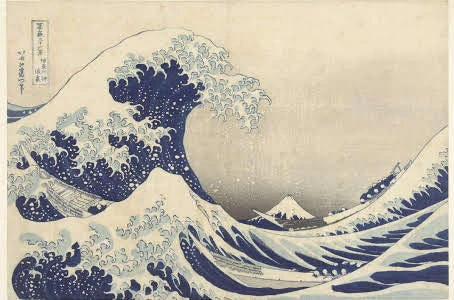
Art is the queen of all sciences, communicating knowledge to all the generations of the world. -Leonardo da Vinci

Scientists are constantly getting better at knowing when the next hurricane, landslide, or flood will happen. However, science communication about these disasters lags behind. As Leonardo da Vinci described, art has a unique power to communicate this type of knowledge to people everywhere.
Natural events and disasters of the past have influenced some of the most iconic art of our time. From Turner’s sunsets to Mary Shelley’s Frankenstein – both were composed in the shadow of the greatest volcanic eruption of our age, Mount Tambora in 1815. The Great Wave off Kanagawa by Japanese artist Hokusai (c. 1829–33) has been interpreted as a warning about tsunami risk. In an era of increasing natural hazards and climate change, art can also communicate the future risks we face.
Art can inspire people to think about disaster risk and resilience in ways that science, data, and numbers cannot. This is why the Global Facility for Disaster Reduction and Recovery (GFDRR) Labs and the World Bank Group’s Art Program and have launched a global call for artwork for an upcoming exhibit called The Art of Resilience. Poetry, painting, photography, music and performances can all tell stories across cultural barriers , building empathy for communities who are facing increased risk from hazards and climate change. Emotions evoked by art can convey a sense of urgency for preventing and preparing for disasters.
We have seen art serve as a convener, a conversation starter, and a source of hope and motivation for people from all over the world. Last year, on the sidelines of FOSS4G and Understanding Risk Tanzania, a mural challenge brought together young Tanzanian artists to communicate visually about risk and resilience. A 19-year-old self-taught artist from northern Tanzania, Nickson Jeremiah, journeyed across the country to Dar es Salaam to participate in the mural challenge, and ultimately won second place. Jeremiah notes that climate change affects mostly women in his village, who endure long miles to fetch water, collect firewood, and ultimately take care of the family. Motivated by these challenges faced by women, his creation portrays a young woman delicately holding her dream city.

The Labs team, in conjunction with the Red Cross Red Crescent Climate Centre, has been exploring the use of art to communicate risk, particularly through DataSculptures - 3D pieces that translate numerical data on disasters into something people can interact with, virtually or viscerally. These sculptures create an opportunity for dialogue that would likely have been missed if it were just a chart. The artist behind these innovative DataSculptures, Pablo Suarez, believes that “Artists can create experiences that make you engage, make you wonder.” One DataSculpture brought to life all the disasters experienced in the Pacific over the last 25 years. A rainfall sculpture from the Nangbeto Dam in Togo helped explain forecast-based financing for floods. A population sculpture from Catalunya, Spain, was combined with augmented reality to show a century of population change, allowing people to literally trace the ripple effect of war or policy changes through the population over time.
In this video, Simone Balog-Way, Manager of the Understanding Risk community, speaks with artist Pablo Suarez about the role of art in communicating disaster risk, and explains how you can get involved.
We know there are many examples of creative pieces that cause people to stop, think and engage on climate and disaster risk. And we want to hear from you. The Art of Resilience exhibit, which will be held at the World Bank headquarters in October 2019, will showcase art forms that highlight, achieve, or improve societal understanding of disasters and climate change. We are looking for a wide variety of artistic approaches, including:
- Two- or three-dimensional works that serve as calls-to-action by stressing the urgency of mitigating disaster impacts and adapting to climate change; works that imagine hopeful futures in a world impacted by these shocks
- Visualizations of big data - data art as an emerging form of science communication
- Public art - installations as a way of putting knowledge about disaster and climate risk into local context
- Musical or performance art – performances or event series that use movement arts, vocal, or instrumental arts to evoke understandings of the immensity of climate and natural disaster risks
- Community-based arts programs - initiatives that engage the public in arts production to support post-disaster reconstruction or deliberative disaster risk management

The Art of Resilience seeks to bring together those who know, those who do, and those who create to inspire new ways of thinking about disasters. Join us in this movement to advance the use of art to communicate risk and create resilience. Please share the call for submissions widely with artists, designers, and makers who are supporting this important mission. To learn more and to apply before the deadline (May 17, 2019) please visit: gfdrr.org/en/art-of-resilience.




Join the Conversation